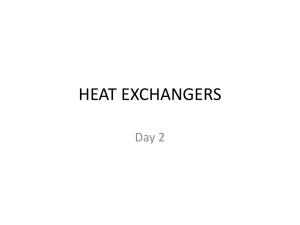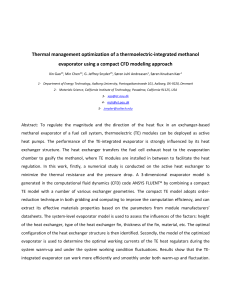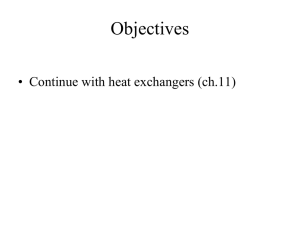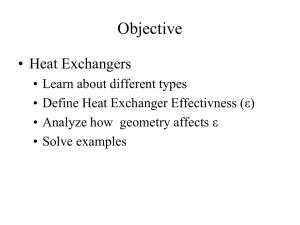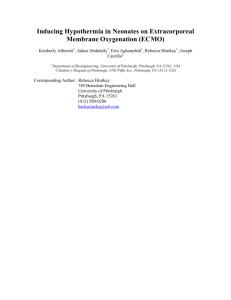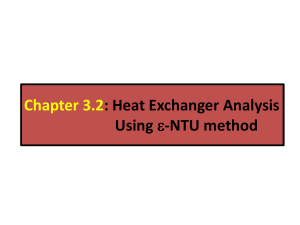free frost heat exchanger for cryogenic automotive propulsion
advertisement
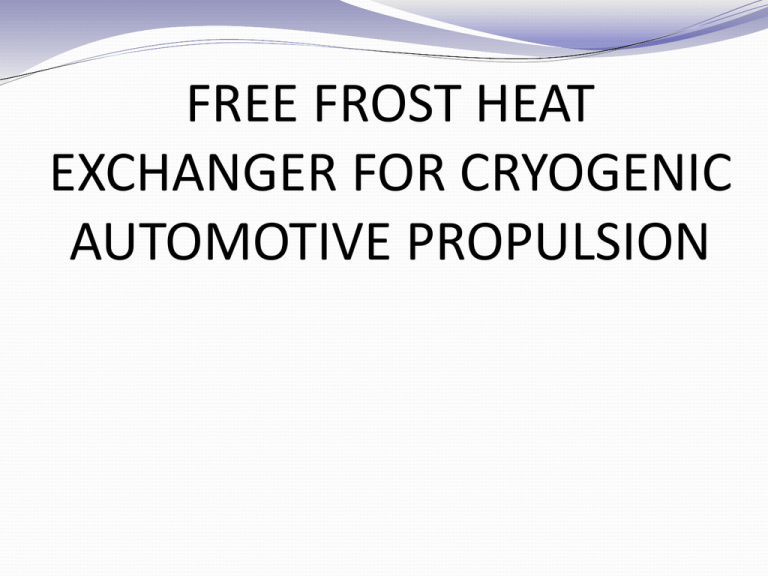
FREE FROST HEAT EXCHANGER FOR CRYOGENIC AUTOMOTIVE PROPULSION CONTENTS • Introduction • Liquid nitrogen propulsion system • Test vehicle • Schematic vehicle of equipment layout • Economizer • Ambient air heat exchanger • Ambient air heat exchange development • Design • Temperature profile • Alternative heat exchanger design • Conclusion INTRODUCTION The cryogenic automobile is a ZEV. Operates on the thermodynamic potential between the ambient atmosphere and a reservoir of liquid nitrogen. The working fluid is a liquid nitrogen A zero emission vehicle is required to produce no smog-forming tailpipe or evaporative pollutants. LIQUID NITROGEN PROPULSION SYSTEM Storage tank Pump Heat exchanger Expander Liquid nitrogen propulsion system TEST VEHICLE Originally electric. Operating on a pack of 14 lead acid batteries which weighed over 450kg. Construction is welded frame with riveted body panels entirely made up of aluminum. Olson Kubvan SCHEMATIC OF VEHICLE EQUIPMENT LAYOUT Liquid nitrogen storage tank (Dewar) Pressurization system Economizer Ambient air heat exchanger Vehicle equipment layout ECONOMIZER Actually a pair of shell-and- tube heat exchangers. Operate in parallel, with the shell-side fluid being the exhaust from the expander. Economizer units with and without shell AMBIENT-AIR HEAT EXCHANGER Made up of 45 copper finned-tube elements. Elements are manifolded together. Make a staggered array of tubes in cross flow with the incoming air. Either the motion of the vehicle, or the two ducted fans located at the back of the van. Ambient-air heat exchanger assembly AMBIENT-AIR HEAT EXCHANGER DEVELOPMENT To design a heat exchanger that can operate in a variety of environmental conditions and structurally robust not being hampered by the build up of frost. Dealing with frost formation fall into two categories: 1) PASSIVE CONTROL. 2) ACTIVE CONTROL. PASSIVE CONTROL Passive control involves either preventing frost formation or over sizing the heat exchanger such that frost build up is unimportant on time scale characteristic of automotive travel. ADVANTAGES • Mechanical simplicity • Reliability DISADVANTAES In general, less flexible in dealing with off-design operation. ACTIVE CONTROL Active control of frost formation entails allowing frost to become attached and then removing it either thermally or mechanically. ADVANTAGES • More operationally reliability. • Much less dependent on the ambient or operational conditions, responsive to different loading condition. DISADVANTAGES Power consumption. Poor-long term reliability. DESIGN The operating environment of a typical automobile can be a demanding one. There are weather conditions such as rain, snow, or extreme heat to contend with. There are driving conditions such as rough pavement, gravel roads, potholes and speed-bumps. Finally , automobiles have to meet rigorous safety, comfort, and reliability. TEMPERATURE PROFILE The black arrows represent heat transfer from the ambient air to the wall. The exterior wall temperature is dependent on the heat transfer coefficient and fluid temperature. when the outside temperature is lower than the freezing point of water, frost will form. when the ambient temperature is above the freezing point of water, if the temperature difference from the air to the wall is too large . Temperature profile of free frost heat exchanger element ALTERNATIVE HEAT EXCHANGER DESIGN A heat exchanger has been developed which uses rotating brushes for active frost-control. This heat exchanger consists of several multi – pass tubes sandwiched between two sets of concentric rings. The cryogenic fluid (either liquid or gas ) flows through the tubing running in cross flow with the ambient air. Heat exchanger employing active frost removal CONCLUSION The cryogenic automobile is a potential contest in the ZEV market, provided certain key technologies are demonstrated. One of these technologies is the development of an all - weather heat exchanger system. A heat exchanger that works well in a variety of operating conditions, is structurally robust, and is not hampered by the buildup of frost is a necessary technology for the cryogenic automobile. REFERENCES www.google.com www.wikipedia.com THANK YOU

